The Leaf Razor: A Painfully Honest Review from my Adventures in Sustainable Shaving
Thinking of upgrading your shave to a sustainable, plastic-free safety razor? After testing lots of (much less painful) plastic-free toiletry swaps, I decided to do the same. So I’ve thoroughly tested three plastic-free razor brands for this review. (TL;DR: The Leaf is the only one that didn’t hurt me.)
These are the razors I tested for this review:
- The multi-blade, pivoting-head, original Leaf Shave razor – my favorite for easy shaving of large areas, eg. legs, with zero plastic and less cuts,
- [Jump to my Leaf Razor review]
- Leaf’s more traditional Twig safety razor – a good pick for faces (so says my husband),
- [Jump to my Twig Razor review]
- Albatross Designs‘ butterfly razor – an affordable, traditional safety razor,
- Well Kept’s safety razor – a heavier, prettier and pricier safety razor.
[Related: I also tested Leaf Shave’s new dermaplaner in a separate review!]
And here’s the story of how that testing started:
You know when you’re shaving your legs and you look down and see a thin strip of pure white, often straight up your shin bone, and you realize it’s not a bit of shaving cream you’ve missed, but a place where you actually sliced off the top layer of skin? (Never shaved your legs before? Try to use your imagination.)
I don’t think I’d experienced this so vividly since I was maybe 14, but it happened again when I tried my first two safety razors.
(This story gets long, as I had to rant about the concept of “self-care,” and the predictable shallowness of so many reviews. But if you’re just here for my review of the Leaf Shave razors, feel free to jump down by clicking here.)
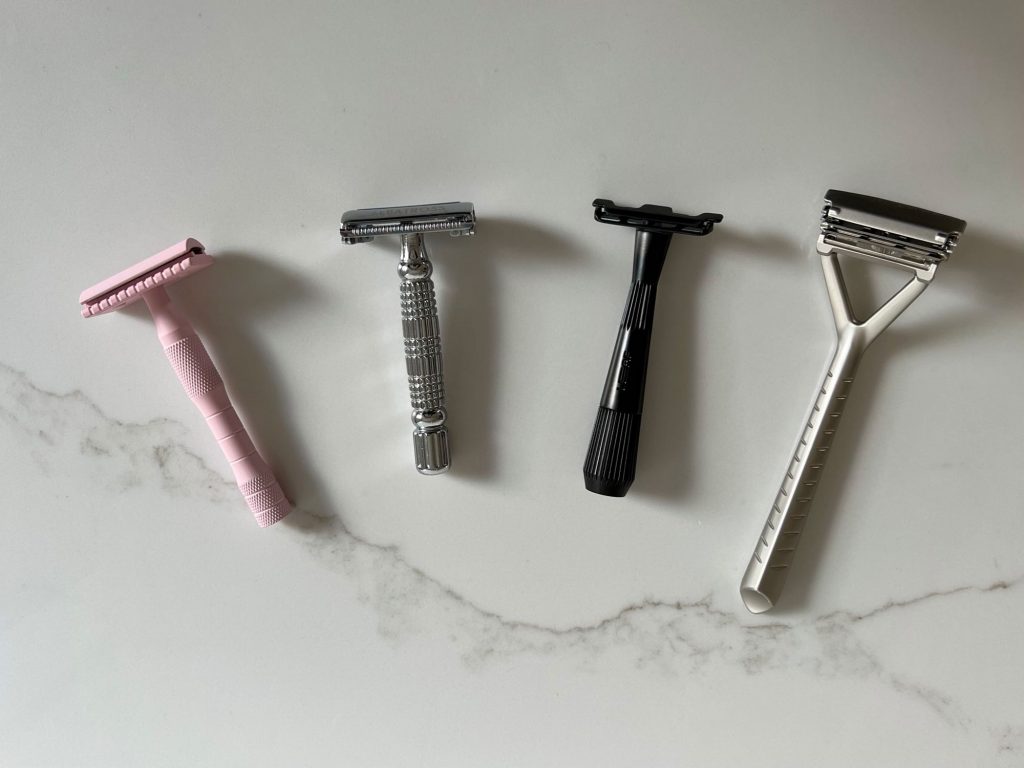
If the razor slides from East to West, even just slightly, instead of sticking to its designated North-South path up the leg, that’s how you’ll get those bright white, missing-skin cuts.
To be clear, the first time I tried these safety razors, I did everything they told me to:
I sat down in the tub, and exfoliated first. I worked up a good lather, and took my time, shaving more slowly and carefully than I have in years. (Albatross on the left leg, Well Kept on the right, so that neither would have an unfair benefit from their place on my safety-razor-learning-curve.)
But despite my care, I still managed to mangle myself equally with both razors:
If you’re squeamish, DO NOT READ THE NEXT SENTENCE: As I drained the bath water, I found strips of my own skin at the bottom of the tub, sliding around like squishy, deflated, little worms.
I’ll spare you the photos of my bleeding legs, but I will tell you the scabs took a month to heal. Six months later, I still have scars.
A word to the wise: You have to be slow, careful and methodical with these tools. It takes time and patience to shave with a safety razor.
Use short strokes, especially when you’re just getting the hang of it. Because shaving with a safety razor is not like shaving with the plastic, pivoting-head razor you’re probably used to.
Both Well Kept and Albatross are very explicit with those instructions, as is Leaf, the multi-blade razor brand I tried later.
Later it occurred to me that safety razors weren’t designed for shaving legs.
I made a mental note to look into the carbon footprint of laser hair removal.
The Sustainable Reality of Safety Razors…
Safety razors these days are almost always sold for their sustainability and “zero-waste” credentials – which are legitimate!
Unlike cartridge razors, safety razors don’t require any plastic, and the blades are actually recyclable because they’re made of just one material (steel – one of the easiest-to-recycle materials we use).
How to Recycle Safety Razor Blades:
Either take them to a sharps collection point, or use some kind of “blade bank” (a safe collection box), so that the people working at recycling facilities don’t get sliced.
All three razor brands I’m reviewing sell blade banks. I use the one from Leaf, which is very affordable and gets the job done. Or you can just use a mint tin to save them up before dropping them off at a metal recycling facility, or sending them back to one of these brands.
Razor cartridges, on the other hand, like the Venus ones I’ve been throwing away for nearly two decades, are generally not recyclable. (You can send them to mail-in recycling programs like this one, but frankly, it’s just not very practical or efficient.)
Like most of the sustainability improvements I’ve made, this is yet another “why did this take me so long?” moment. But there’s no point in that kind of thinking. I’m here now, and that’s what matters.
And besides, the real question should be: Why is the default option we’ve been sold so bad?
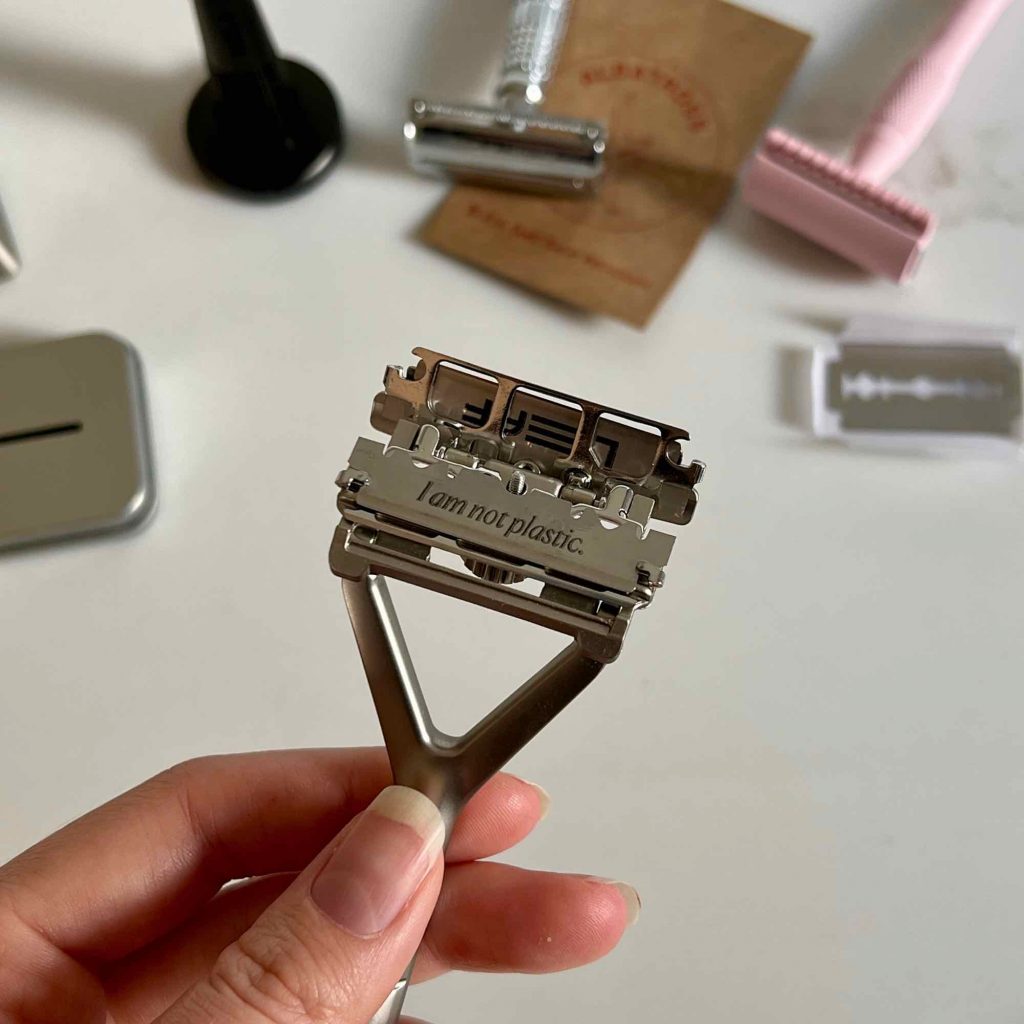
A lot of the genuinely sustainable products I’ve reviewed, which today are sold as innovations of an idealized “zero-waste lifestyle,” are really just a return to a more old-fashioned way of doing things.
The humble bar of soap is the probably the best example.
Because over a couple of generations, we’ve been convinced by million-dollar marketing teams that high-quality skincare and hair care could only exist in liquid form.
And maybe for several decades it was true. But now you can get great face wash in a bar (I love this kind), and great shampoo and even conditioner in a bar (these are my favorites).
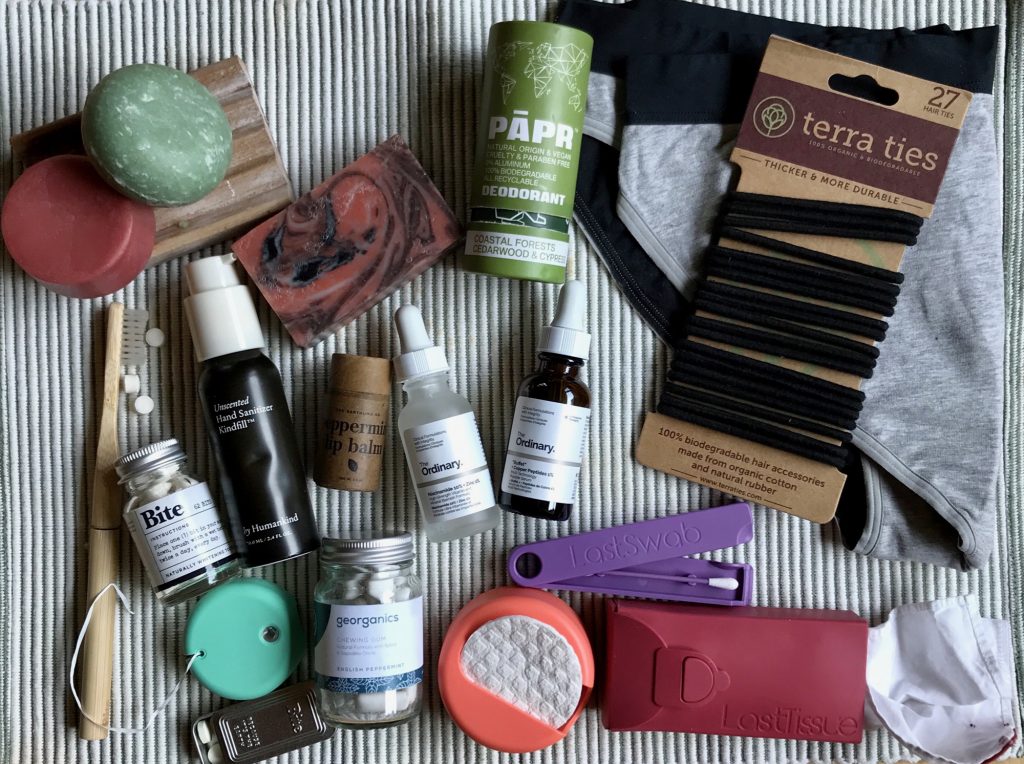
And all of that got me feeling confident enough to try more sustainable shaving options, too.
But if those other toiletry items are proof that we don’t need nearly as much plastic in our everyday lives, then razors are the perfect exception to prove that rule. It didn’t take much testing to realize why people – especially people who shave their legs – switched from safety razors to frankly anything else.
Safety Razors vs. Cartridge Razors is just not the same category as Shampoo Bars vs. Plastic-Bottled Shampoo. It wasn’t just a triumph of marketing on this one.
… And The “Self-Care” Marketing Racket
But now, the next generation of marketers is selling the idea that shaving with a safety razor is about “self-care.”
(And they’re not referring to the post-shave first-aid you’ll be giving yourself until you get the hang of it.)
They want it to be about taking back a moment in your day that’s become yet another rushed activity. We’re told to make shaving into a calm, slowed-down moment of relaxation, contemplation, and something else that I’m not sure of, because I never quite get to the end of these sentences before my eyes roll.
Here’s the thing: The amount of time I spend shaving my legs is not a function of how much I care about myself, it’s a function of how much else I have to do that day.
Shaving with a safety razor can be relaxing if you want it to be that. If it works for you, more power to you.
But masking the significant learning curve with language about “self-care” is just misleading.
The line shouldn’t be, “Slow down because shaving should be a moment of reflection,” instead of the reality: “Slow down because these CAN’T be used quickly or YOU’LL HURT YOURSELF.”
Well Kept vs. Albatross, Continued
When I finished carefully shaving my legs, I slowly glided the Well Kept razor over each armpit, my fingers locking it a death grip and my eyes wide with terror and focus. My doubts about the value of shaving as a self-care activity solidified.
I just kept thinking of all the self-loving cocktails I could be drinking instead of maiming myself with an 18th-century invention undoubtedly designed for men’s faces, not my curvy legs.
“Safety,” by the way, is a relative term that was meant to contrast safety razors with the predominate technology of the era: Unprotected straight razor blades, like the ones used by Sweeny Todd.
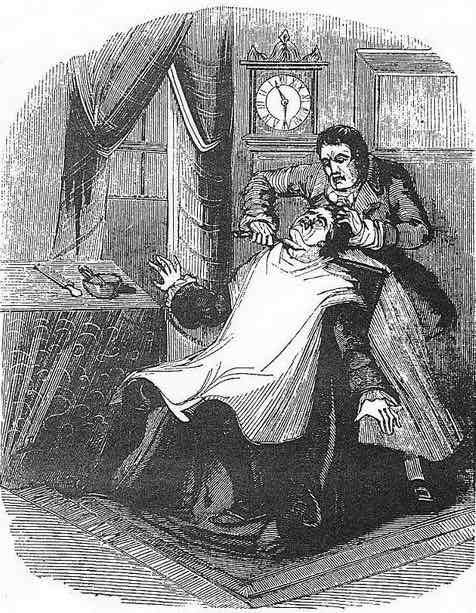
Because the design of most safety razors – whether they’re sold as zero-waste, as self-care, or as $2,500 status symbols – hasn’t changed much since then.
(Update: The company that makes those status symbol razors read this review, and for some reason still offered me a discount code to share with you. So if you shop through the link above, it’ll save you a cool $375.)
When I got dried off, I realized my leg wounds had stopped bleeding more quickly than expected. I didn’t even have to stick little pieces of toilet paper to my cuts. (Maybe the sharper blade, or the lack of wires holding it in place, like on a disposable razor, had made a cleaner cut that clotted more quickly?)
And the single blades had given both my left leg (Albatross) and my right leg (Well Kept) very close shaves with just a single pass.
Where I still had skin, it was impressively smooth.
Even my armpits, I realized the next day while swiping on my cardboard tube of deodorant, had none of the irritated red bumps that I’m used to seeing after shaving, and only an average number of small nicks.
But should I really have to bleed for those results?
While I’d planned to take my two new safety razors along for a month in Europe to keep testing them, I was so generally disappointed that I decided to try something else, too.
The Leaf vs the Twig razor
Leaf Shave Co.’s unique, original razor design is a combination of a safety razor’s plastic-free ethos with the legitimate modern improvements of a pivoting head and multiple blades.
Leaf’s newer model, the Twig, is much more like a traditional safety razor. (A single, exposed blade that’s fixed in place.)
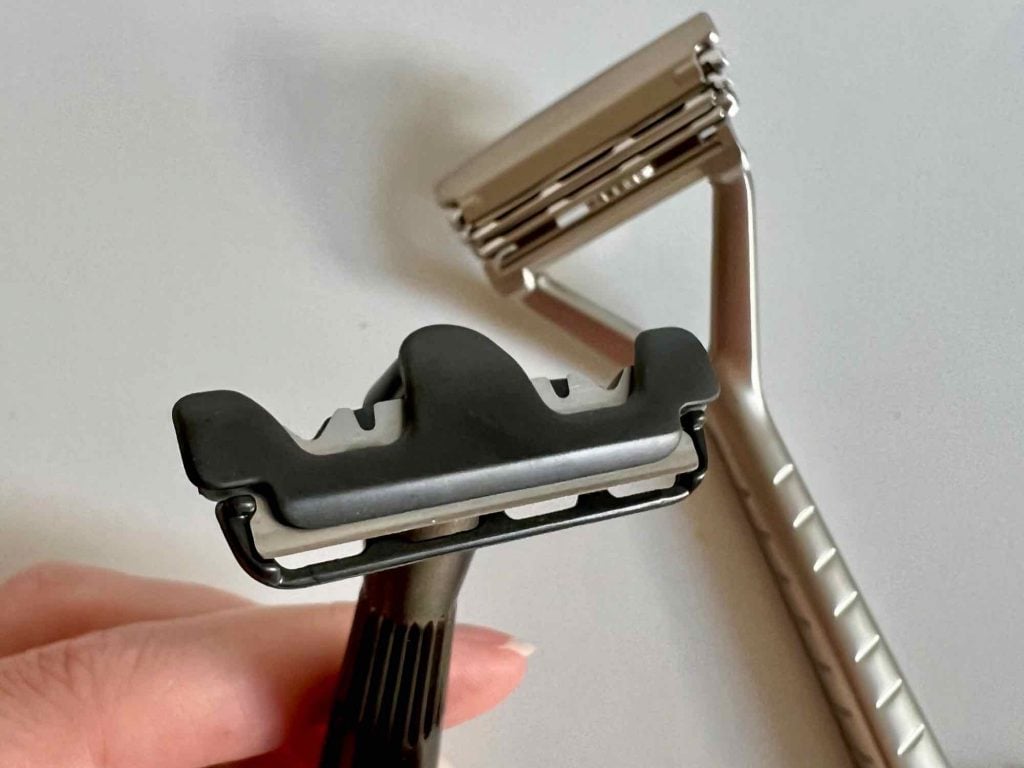
Note: Leaf sent me both of their razors to review, along with their shaving soap bar, razor stands, and extra blades. And Earth Hero sent me the Albatross and Well Kept razors, which I also really appreciate! (This is how I’m able to compare so many pricey products – and hopefully help you figure out the difference without wasting lots of cash. Although I received the products for free, this is not a sponsored or paid review, and my (many) opinions expressed here are my own.)
Leaf Razor Review
I tried Leaf’s original, pivoting-head razor for the first time under subpar conditions: Jet-lagged, in a tiny Italian shower much smaller than I remember phone booths being.
I didn’t put in nearly as much effort with the Leaf razor as I did with the two safety razors – but I got much better results.
Granted, I didn’t try to be quite as thorough as I had with the first two. I skipped the areas where I had thick scabs from the safety razors. (One shin, part of the other knee, and the backs of both calves. Yes, I even cut my calves.)
But this was a much more real test: Instead of sitting down in a bath tub, I was standing up in a shower so small I didn’t even have enough space to bend down to my toes, so I had to awkwardly contort each leg upward. Instead of lathering with the fancy shave soap bar Leaf had sent me (and that I forgot at home), I used a sparse coating of my husband’s grandmother’s body wash.
Instead of feeling calm and relaxed for my self-care ritual, I was in a rush, because I was tired, and I was writing this review in my head. I didn’t exfoliate first. And, the final offense, I shaved straight over my knees – speedily. Recklessly, even.
Pros of the Leaf Razor:
So even after doing everything wrong, I didn’t cut myself even once the first time I used the Leaf.
That pivoting head that I thought might just be another gimmick was actually a game-changer.
After months of use, I can see that the Leaf isn’t totally magic – but it is just so much better. I’ve occasionally nicked my knees a bit with it, but it’s just like when I’m moving too fast with a cartridge razor: They’re pretty minor cuts that usually disappear by the time I’m out of the shower. (Nothing like my painful safety razor wounds.)
At the end of the day, the Leaf was an unexpectedly excellent result in a category (sustainable shaving) that I was beginning to think was all zero-waste hype.
Choose-Your-Own-Adventure Shaving
The first couple of times I used it, I thought my shave with the Leaf wasn’t quite as close as with the traditional safety razors.
But, to be fair, you can customize the closeness of your shave with the Leaf razor. The razor has slots for up to three blades, and I started with just two.
If you put a blade in each slot, you’ll have something comparable to a triple-blade cartridge razor – and the closest shave.
But if you have sensitive skin (or just want to play it safer) Leaf recommends using just one or two blades, and leaving the slot for the blade that sits closest to the skin empty. That’s what I started out with.
For that reason alone, the Leaf is easily the best safety razor for beginners.
(Even though it’s not really a safety razor. Which is, of course, why I love it – all of the sustainability with none of the suffering.)
Another factor contributing to a less close shave is that, as you may remember, I did everything wrong. (Well Kept and Albatross had the benefit of exfoliation, focus and shaving cream. The Leaf razor got none of that.)
Cons of the Leaf Razor:
After several months of use, I only have two complaints about the original Leaf razor:
First, the handle doesn’t have much grip (although Leaf sort of has a solution for that, as I describe below). And second, the razor is quite heavy. Both of those mean it takes some getting used to the Leaf when switching from a plastic razor.
So while it’s not as heavy as most traditional safety razors, it can be hard to keep a grip on the Leaf. (Frankly, that’s true of all the razors I tried, but I had bigger concerns with those, which made the handle almost forgettably minor. Really, I’m being very picky to find something about the Leaf to criticize.)
Razors by Weight
The Albatross short-handled razor weighs 71 grams (2.5 oz.), and is just as slippery as the Leaf.
The Well Kept is the heaviest at 98 grams (3.46 oz.), but one thing I do prefer about it is the handle has sharp waffly grooves that give a better grip for wet hands.
The Leaf weighs 83 grams (2.93 oz.), and the Twig weighs 70 grams (2.47 oz.).
That heavy weight is an intentional part of the design of traditional safety razors. You’re supposed to let the weight do the work and not apply extra pressure.
But I think the lighter weight makes the Leaf easier to maneuver than the Well Kept.
Or at least it makes the Leaf easier to maneuver fast – the way I’m used to shaving with a super light-weight Venus razor (which weighs in at 23 grams, or .81 oz. That’s why I’ve used Venus ever since my backpacking days, when I discovered the handle was lighter than other brands’ metal handles.)
Twig Razor Review
I tried the Twig on my legs, too, but it just didn’t really feel like the right tool for the job.
With the Twig being a little lighter and much smaller, it feels easier to maneuver into small spaces than any of the others. (Confirmed by my husband testing all of them to neaten up his beard. He said the larger heads on the other safety razors blocked the view of what he was shaving, while the Twig is smaller, so he could see what he was doing.)
The Leaf isn’t as agile in this sense.
According to Leaf Shave, that’s kind of the point – the Leaf razor is designed for tackling bigger areas like legs, while the Twig is more about detail work and getting into small spaces, like faces.
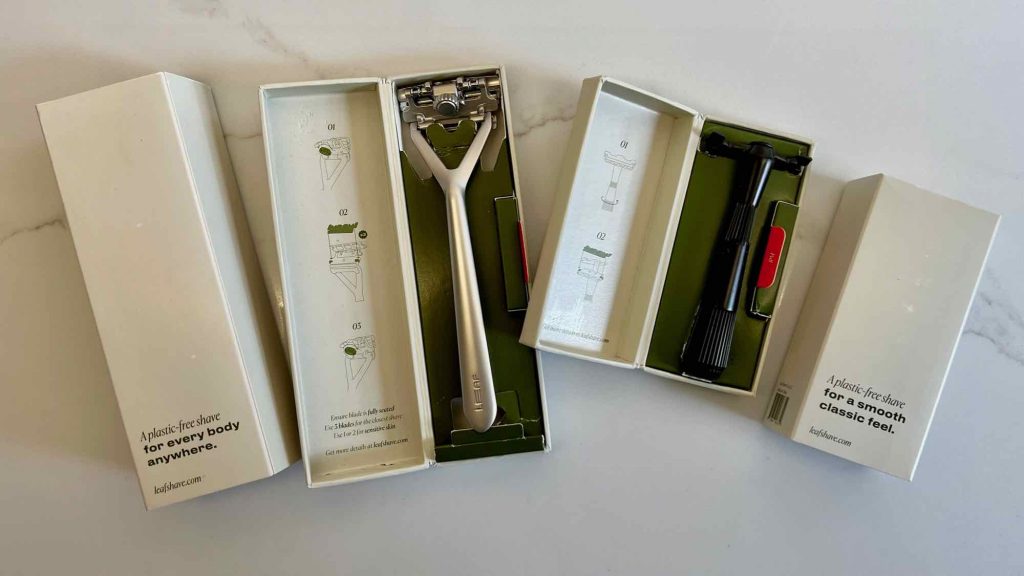
Leaf Shave Accessories
The Leaf Razor Silicone Handle Grip
I asked Leaf about the slippery handle issue. They reminded me to make sure the handle and my hands were soap-free (which probably won’t be happening, if we’re being realistic).
They also suggested I try adding their silicone grip sleeve to the handle.
The silicone grip did help, but honestly, not as much as I was hoping. Which made me realize that maybe the biggest thing to get used to when using a safety razor on your legs is the weight of the razor, more than the smoothness of the metal grip.
Still, I used the Leaf on both legs with the new grip, speeding right over my knees and everything, and came out of the shower with a smooth shave and no cuts.
UPDATE: After using the Leaf and grip sleeve consistently for about four months, the bottom part of the grip has broken. It’s still usable, but it’s clearly a patch on the problem, and isn’t as durable as the razor itself. Leaf told me they’re working on a new design that might include a grippier handle.
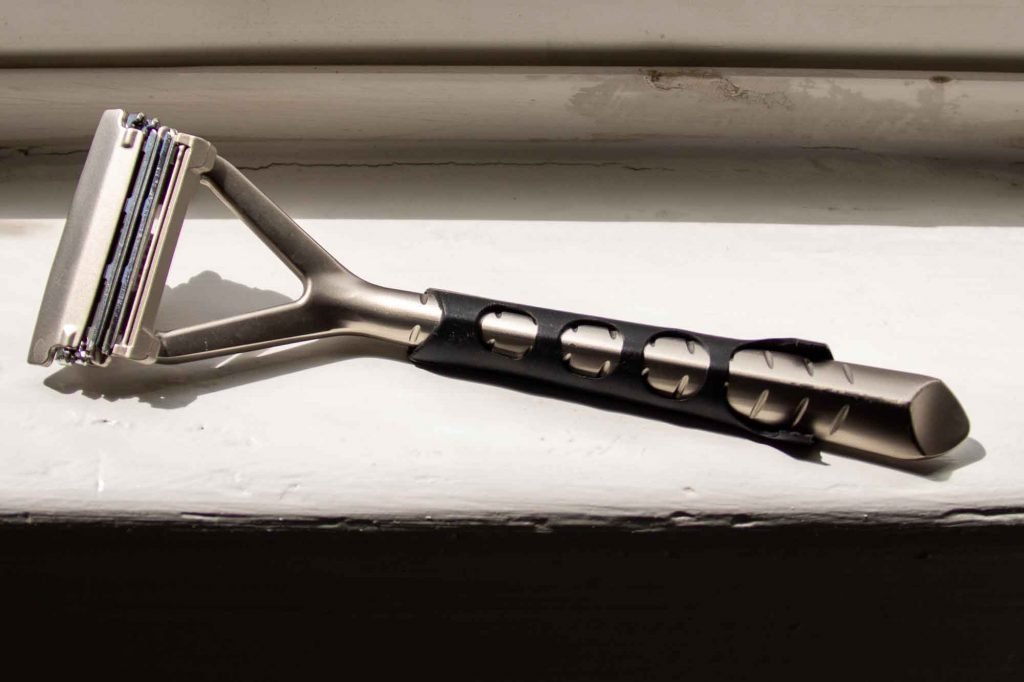
Leaf Shaving Cream Bar
Leaf’s “shave soap” bar is excellent! It was probably the most surprising find of this entire review process for me.
It lathers really easily, with just a couple of swipes up my leg, and feels quite moisturizing, even after washing it off. It’s unscented, but to me it clearly smells like cocoa butter (which is one of the moisturizing ingredients on the list).
I will definitely keep using it.
Prices & Discounts
The original Leaf razor is also $84, and the Twig safety razor is $59.
The Well Kept costs about $84. (Slightly less on Earth Hero, which often has the best prices on sustainable products – and I spend a lot of time comparison shopping these sites. Plus you can save 10% with the code tiltedmap10 .)
The Albatross razor costs around $30, and Earth Hero carries it at the same price.
Where to shop around & (maybe) save:
- You can always save 10% on any Leaf razor directly from Leaf Shave Co. with the discount code KETTI10.
Otherwise, here are a few good sustainable retailers that carry the razors in this review (at the time of writing):
- The Package Free Shop sometimes has discounts on Leaf razors.
- The Detox Market carries Well Kept razors and, again, sometimes offers discounts.
- Earth Hero has some of the best credentials in the industry (B Corp, carbon-neutral, and member of 1% For The Planet), not to mention often the best prices. (Even before the 10% off with my discount code, tiltedmap10 .)
- Grove Collaborative carries Leaf Shave products, and sometimes offers deals for new customers, so be sure to click through and check. Grove is B Corp that will be plastic-free by 2025.
(Note: Grove uses a membership model, so make sure you cancel within 60 days if you don’t want to be billed. Also, they will usually basically force you to take some free gifts from Mrs. Meyers. Depending on whether you’ve already switched to plastic-free cleaning products, that’s either an added bonus or just annoying.)
Razor Blade Prices
In the long run, the blades are where you’ll save: replacement blades are just a few cents each for any of these razors!
Compare that with about $2 each for replacement Venus cartridges (or any similar razor cartridge brand, at least on the women’s side), and you start making back that initial investment pretty quickly.
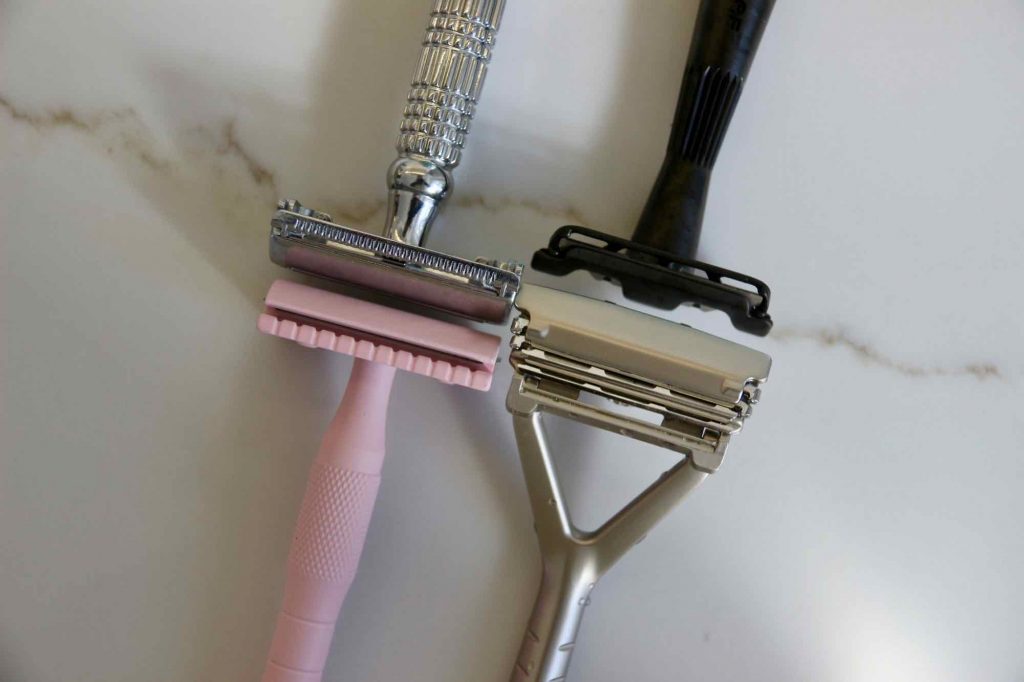
Safety Razor FAQ:
Can you take safety razor blades through airport security?
While technically you can’t pack safety razor blades in your carry-on, I have so far gotten away with it about a dozen times at airports in the US and Europe. (Including visiting this “plastic-free” island in Greece!)
TSA did want to take a closer look at my razor – just once so far, flying out of Boston. The agent looked at the razor, and just asked me to remove the blades, which they confiscated. Of course, I kept the actual razor (and the stash of replacement blades that they didn’t notice in my toiletry kit, mwah-ha-ha!)
Surely using a safety razor gets better with practice?
Yes, obviously. I would also get better at flying a fighter jet with more experience, but that doesn’t mean the learning curve is worth the time investment. Not to me, at least.
And it might not be worth the time or actual money investment to you.
Between my frustration with the self-care hype, and my general bad experience with safety razors, you might think I just didn’t slow down enough to make shaving with a safety razor work.
Or maybe I didn’t read the directions?
No.
For the record, I am the designated de-tangler of cords and necklaces in my house because of my ability to do menial tasks with calm and patience.
I read all the “how to use a safety razor” guides before starting this process. They ll told me the same things:
- Hold the razor at a 30-degree angle to whatever you’re shaving – which sounds complicated, but is really just the natural angle your hand will take if you’ve ever shaved before. Don’t be intimidated by the math-iness.
- Don’t press down. Let that heavy-metal weight of your safety razor do the work, but don’t add any extra pressure.
- Use short strokes. AKA don’t shave all the way up your leg in one go, because you might skin the whole damn thing before you realize what you’ve done.
Got it, got it, and got it. Didn’t work. (I skinned just short sections of each leg at a time.)
Still, in the name of science and being a good reviewer, I went back and used all four razors several more times. (Once I recovered from my first shave, that is, which I’d foolishly thought the Internet had prepared me for.)
I’ve tested EVERY combination of exfoliation, shaving cream, angles, pressure and patience with ALL of them. Using the safety razors has gotten better. (A little bit.) But it hasn’t become enjoyable, easy, or fast.
I still cut myself every time, just not quite as severely.
But the Leaf had no learning curve! And the quality feels just as high as the others, and shave is just as good. So I just don’t see the point of anything else, unless it’s to save money on the initial investment.
Different Razor Blade Sharpness
Any of the razors in this review can be used with any brand of blades – that includes both Leaf razors, with their single-edge blades. Just snap any standard, double-edge blade in half, (while it’s still in its paper wrapper!) to use it with either Leaf razor.
While falling down one of my research rabbit holes, I started digging into the different sharpness of different brands of safety razor blades.
This was far more detail than I ever hoped to read about razors and blades, but as it turns out, there’s a lot of variation in sharpness between different blade brands. So if you try one you don’t like, you can try another.
The blades that come with Well Kept (Astra brand’s Superior Platinum) are sharp, but not sharpest around. In short, I didn’t learn anything that explained all the cuts. (I couldn’t find any data on Albatross’ blades.)
Do metal razors rust?
After feeling a little traumatized by my first encounter with both the Albatross and Well Kept razors on a Sunday evening, I ignored them for a day or two.
On Tuesday morning, I remembered the instructions all said to disassemble them, and rinse the components and let them air dry after EACH use. I’d rinsed them, of course, as I would have any razor after using it, but skipped the thorough wash-and-dry.
So I plucked them out of shower and started unscrewing the heavy metal. The Albatross seemed perfectly fine inside, but the Well Kept actually had little bits of rust forming – after less than 48 hours!
Well Kept told me the rust is from the blade, not the actual razor, which is brass so it doesn’t rust. (Because it doesn’t contain iron.) But I tried to wash the rust off the razor handle, and surprisingly it didn’t come off very easily.
UPDATE: After about 6 months of use, I haven’t seen any rust develop on either Leaf razor, and I’ve been mostly leaving them in my shower just like the Well Kept. (The Leaf razor stands might be helping with this.) I haven’t seen any rust on the Albatross either, but I’ve mostly given up on it, so it hasn’t been living in my shower.
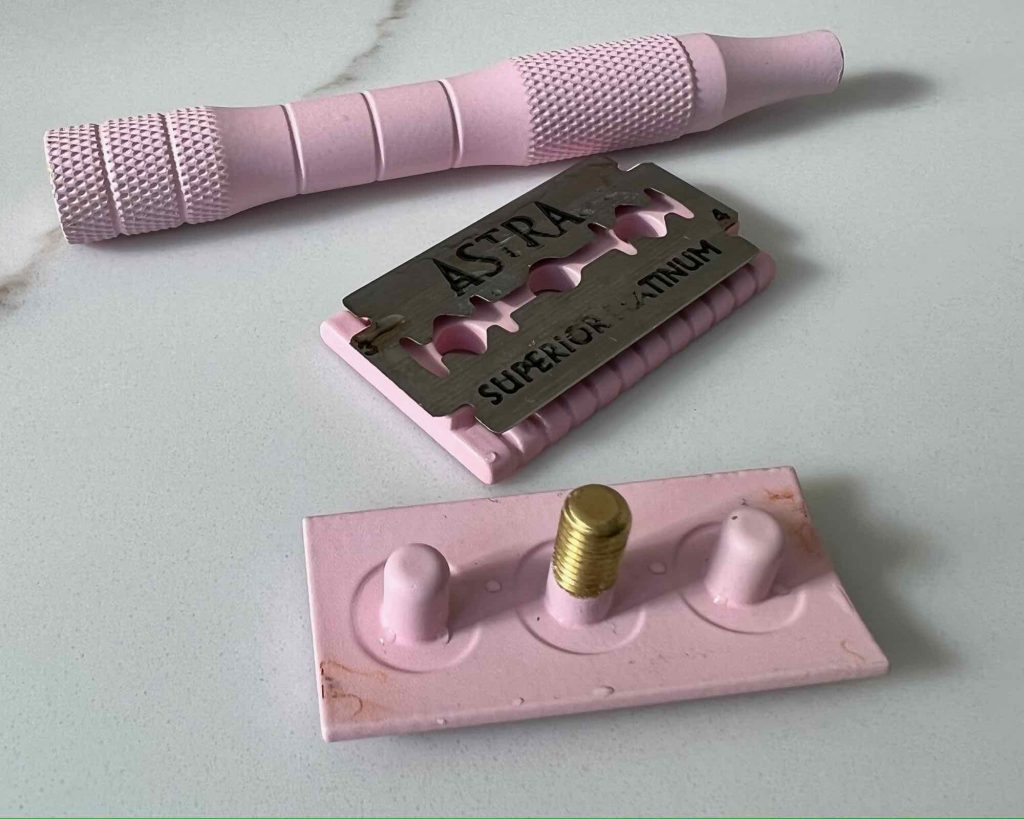
Rant #2: The Shallowness of Online Reviews
That’s all I have to say, review-wise. So I just thought I’d warn you that I’m about to go down a few rabbit holes… Read on if you want to get analytical.
This review, like all of the product reviews I write, is just my experience. There are certain others out there.
But consider my experience your fair warning and please, be weary of blogs telling you shaving with a safety razor is “omg totally easy!”
Before I took on this project, I read dubious reviews asking hard-hitting questions like, “Is shaving with a safety razor dangerous?” Answer:
“Nope! Lots of people think shaving with a safety razor will be dangerous, but it’s honestly not true.”
Excuse me while I honestly go change the dressing on my razor-inflicted wounds.
These reviews have sunny titles like, “Scared Of Using A Safety Razor? I Was Too—Now I Love It,” to which I ask a resounding, REALLY???
If you love shaving with a safety razor, more power to you.
But the writer calls her safety razor, “an ‘easy win’ when it comes to living more sustainably,” and I just find that a little hard to swallow.
A bar of soap is an easy win when it comes to living more sustainably. Go try this one instead of body wash in a bottle if you want an easy win.
Safety razors, in my honest experience, were a painful loss.
Maybe those reviews are exactly what those writers experienced, but I feel like they’re glossing over some important details.
Because I’ve been working on this plastic-free living thing for a while, and often my take-away message when I review sustainable products is a wholehearted JUST TRY IT.
Look, I go to great lengths to find what I consider the best products in each category, and I probably give far too many details in my reviews (here’s 5,000 words about sustainable toothpaste).
But I usually don’t feel a huge burden of responsibility to warn you, dear readers, about what you’re getting into.
Most of these are easy decisions, which reduce the environmental impact of our daily routines, with very little downside.
(If you take my advice, my favorite eco-friendly toothpaste tablets will not make your gums bleed. Great shampoo and conditioner bars won’t burn your scalp off.)
But safety razors can actually hurt you if you don’t know what you’re doing. (Or if, like me, you think you do.)
What’s more, they’re not exactly small investments for basic hair removal!
And, if you’re thinking about buying a safety razor, there’s a good chance it’s because you want to throw away less stuff. So you’d probably be frustrated to see an expensive metal razor became just another piece of unused junk in your medicine cabinet.
So I get very frustrated seeing so many articles taking this lightly to earn an affiliate commission. And they make me wonder – has anyone actually used these before writing about them?
To be clear, that’s how blogs (Tilted Map included) and major review websites work:
You click on a shopping link, and the website earns a commission from the brand if you buy anything (without any extra cost for the buyer).
For example, I can make a commission if you click through the links to buy any of the products I’ve reviewed here. (Not only my top recommendation, but also the razors I don’t recommend.) And again, my commission doesn’t cost you anything.
Again, I got these products for free to write about them. But that doesn’t mean I’m going to skim over the reality of using them.
This isn’t a sponsored review. No one is paying me to write this. (I prefer it that way, because I like to feel free to write whatever I want… as you may have noticed.)
But I cannot pay rent with free razors.
So I appreciate if you click through my links for any shopping you might do!
Bottom Line Recommendation
If you’re sure you want to try a traditional safety razor, I’d like to recommend the Albatross butterfly razor, because I like the unique butterfly-style opening. (It’s quicker and easier to open the Albatross razor for cleaning or changing the blade than the Well Kept.) At $30 it’s a much more reasonable price for what I consider the gamble of a safety razor, and it still feels high quality.
But I do think the $84 Well Kept razor is easier to use because of the better grip on the handle. (If you’re shaving your face, or shaving your legs outside of the bath or shower, and keeping those hands dry, this wouldn’t be as much of a problem.)
But Leaf’s $59 Twig razor is the only one my husband wants to keep using on his face, so maybe the above considerations aren’t worth so much. (And I think its elegant way of twisting open is cooler than Albatross’ butterfly opening.)
Personally, I’m going to keep using the multi-blade, pivoting head Leaf, and I think it’s actually worth the $84 price tag. For my legs and armpits, it’s really outstandingly easy and safe to use, and from what I can tell of quality, I think I’ll be using it for many years to come. It’s the only one I’m recommending to friends without a lot of caveats.
Don’t forget to use the discount code KETTI10 to save 10% on anything you order from Leaf Shave Co.! (Otherwise, check out my list of discounts above for other options.)
If you have questions, or suggestions for products I should review, leave them in the comments below!
Check out some of my other favorite sustainable product reviews:
- SBTRCT solid skincare, fresh from the UK
- Viori shampoo bars, with traditional rice water from China
- Activist Skincare review (a rare, truly refillable skincare line)
- Sustainable Gift Ideas (Including the Leaf)
- My favorite shampoo & conditioner bars
- Lots of other shampoo & conditioner bars I’ve tested
- Several brands of period underwear (including some more sustainable alternatives to Thinx)
- Several brands of toothpaste tablets (some great, some never-again)
- LastObject: Reusable Q-tips, cotton pads & tissues – and tips on how to avoid greenwashing (AKA fake-sustainable companies)
- Cleaning & laundry products, sans plastic
- Plastic-free (but not hippie-ish) deodorants
- Everything I learned in a master’s degree in sustainability!

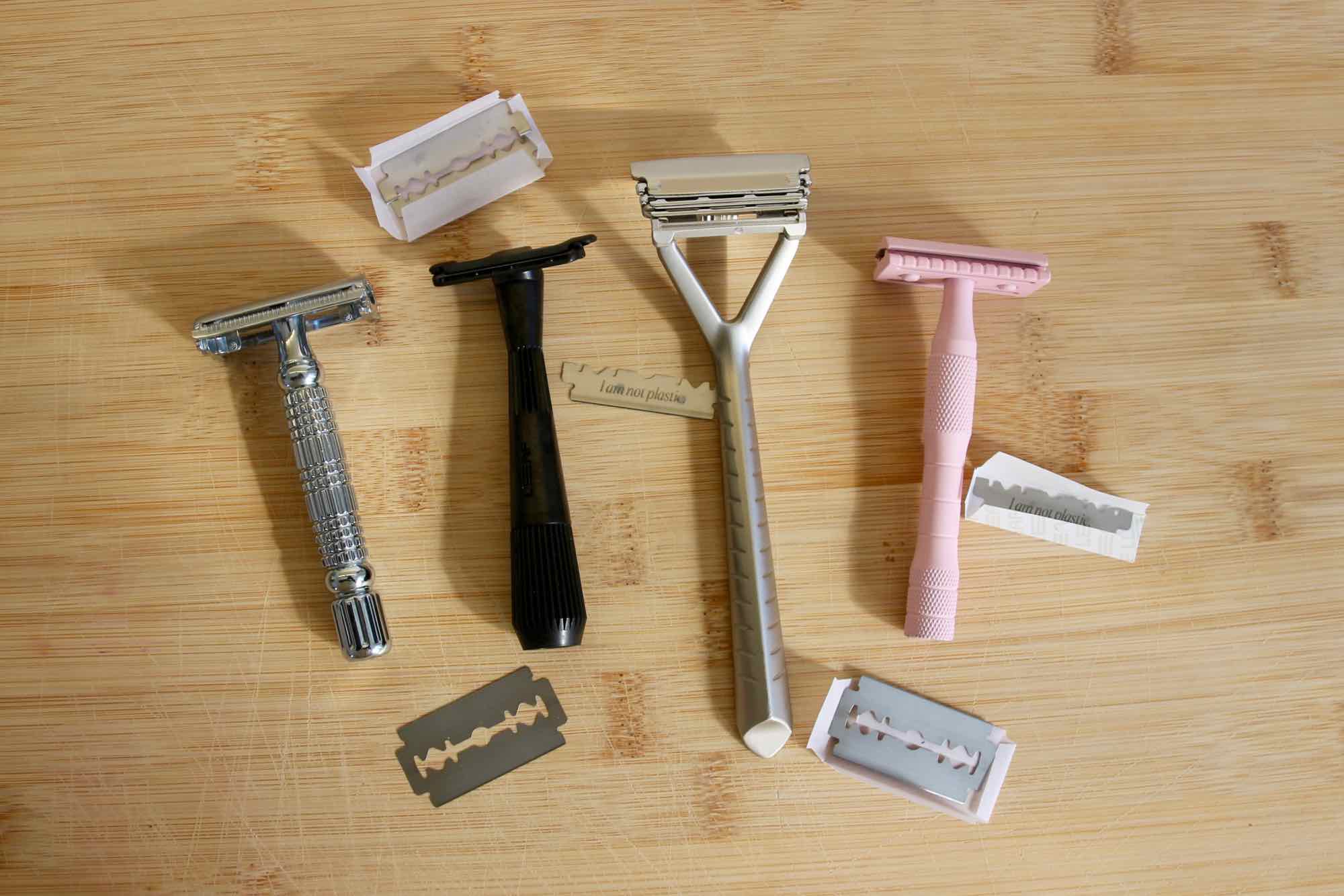



![Visiting “Clean Blue Paros” [The Reality of Greece’s Plastic-Free Island]](https://www.tiltedmap.com/wp-content/uploads/2021/12/Paros-Greece-Naousa-port-sailboats-©KettiWilhelm2021-768x512.jpg)


Another great, informative article. I appreciate your perseverance and honesty when reviewing sustainable products!!
Thank you!
Thank you, Kelly! Comments like yours make my day. 🙂
Cheers,
Ketti
Wow… I was looking into the Leaf razor & stumbled across this article & was extremely pleasantly surprised to have found this well written, detailed, & hilariously relatable product review. Your writing style is so delightful & now I can’t wait to read all your other product reviews! Keep up the great work girl.
❤️❤️❤️ Thank you so much, Isabella, your comments truly makes my day!
I hope you enjoy the other reviews just as much, and if you ever questions of products you’d like to see me write about, just drop me a line!
Cheers!
Ketti
People shaved their legs for years with safety razors without injuring themselves. I know people that still use a safety razor on their legs and have fewer nicks than when using disposable razors. I use a safety razor on my face and no longer have razor bumps. I also nick myself so rarely that I’m surprised when it ever happens. It takes time and practice to learn how to use a safety razor properly. Each handle is different so the angle and amount of pressure needed is slightly different for each. But, also, each blade is different. Some blades are literally razor sharp, they’re very aggressive, while others are a little more gentle or mild because they’re not quite as sharp. Still others may seem dull right out of the package to some shavers. These subtle (or maybe not so subtle) differences can mean the difference between a smooth shave or a blood bath. Personally, I use the German made Wilkinson Sword blades. They’re sharp but not in the top tier of sharpness but they do seem to cut smooth and with less friction. People with coarse beards may prefer the Japanese made Feather blades. These blades are the sharpest available on the market today (as far as I know). But, they’re also very aggressive. You better know what you’re doing with these blades. Not recommended for the beginner safety razor shaver. Others prefer the Derby blades. These have a smooth cutting edge but are definitely on the mildest end of the scale when it comes to sharpness. These are great for beginners and for people with sensitive skin. They are also great for sensitive skin areas, like legs, underarms, and public areas. There are many other brands available. Keep in mind that within the multiple brands there are multiple styles of blades. Each brand may have 2,3,5,or even 10 different style blades. Although choosing a handle went fairly quick for me (maybe 1 month), choosing a blade probably took me about 6 months. I wasn’t sure if I wanted a short handle or a long handle so I shave for a week with each twice. With the blades, I tried the sample packs and pretty much tried as many blades as possible setting aside the blades I liked most. Then I figured out which of those would be my daily blade.
Hi Charles,
Thanks for your comments! As I said multiple times in my article, yes, of course, people can learn to use safety razors on their legs without injuries, but it’s not automatic, and it’s nothing like using a standard cartridge razor. There is a learning curve, and that is almost never talked about other reviews.
Thanks for sharing all those details about different blades. Other readers might find that useful!
Thanks for reading and keep in touch!
Best,
Ketti
Man, I have to disagree on a lot of this. For context I use the albatross but have used one other – dont know the brand but it had a wooden handle. I love to read people reviewing something honestly online, bravo to that. But I have never ever had the skin strip thing happen to me with any razor, I’ve never even heard of it. Maybe it’s more common than I think though! I found the shift to a safety razor really easy. Here’s my experience with cutting yourself shaving – With plastic razor: often not painful at all but bleeds forever, happens often. With safety: hurts for a moment but hardly bleeds and isn’t big enough to see, happens way way less often (probably bc you’re being more careful). To be fair – I don’t shave often (1x per week) so taking a little more time is okay with me – it does take more time, you have to go slower. But other than that I found it shocking how similar to a plastic razor it was. Anyways, I’m thinking of switching to the Leaf and this was helpful! Just hate to think that people will read this and be turned off and scared. Hate that you had a rough time, that’s shit to have scars from the experience!
Hi Allie,
That’s so interesting! As I said in the article, I went super slowly and carefully with the safety razors, too, and I was pretty confident that following their instructions to a T would make everything go just fine. (You might not have read that part – this was a long review, even by my standards.) But the cuts were some of the worst ones I’ve ever had, and not just the first time I used them. (Still sort of can’t believe I actually went back for more after the first bloodbath.)
And I was really frustrated having that experience after reading SO many other reviews that made it sound like switching to safety razors should be the easiest thing ever. So my attitude was basically the same as yours, but the other side of the coin – I don’t want people to read those reviews, buy a safety razor thinking using it will be similar to using a plastic cartridge razor, and then just end up with another expensive gadget that they’ll never use.
Whereas for me, using the Leaf razor actually does feel very similar to my old Venus cartridge razor. I think so many zero-waste product reviews glaze over the details and try to get people to switch for the sustainability benefits (and, of course, for the commissions) without considering that if you get people to buy a “zero-waste” product and it’s not right for them, it’s still just more waste.
(And I earn an affiliate commission on all of these brands, so for me it’s all the same. I just want to be straightforward and hopefully actually help people to find something that will work for them longterm.)
Anyway, thanks for sharing your take, and for appreciating honest reviews! There are still a few of us out there writing them! 🙂
Keep in touch!
Ketti
Found this article while looking for sustainable razors as I transition to plastic-free living. My difficulty is that I *despise* a pivoting head. I cut myself terribly every time I try to use one. Maybe I’m an anomaly, but I actually get the best shave with a plain ol’ Bic Silky Touch. So I’m looking for something similar to that, but obvi not so wasteful. Do you think the Twig is comparable? On the other hand, I might be fine with any “safety” razor since I think the deal with them is the fixed head–but your post, while I appreciated the honesty, really scared me off, to the point that for now I’ll have at least one more package of Silky Touches under my belt…
Hi Emily, thanks for getting in touch!
That’s so interesting that we have the opposite experience in terms of which razors cut us up! You’re right about safety razors – that the definition is linked to the fixed head. I know some people say they don’t have any trouble with them, but I was just amazed by how much that was NOT the case for me. But as you said, since you’re used to a fixed blade, maybe you’d be fine with them.
The Twig was definitely my preference of the 3 fixed-head safety razors I tried. It’s the lightest one, and to me, feels like the easiest to grip and maneuver. (My husband also preferred it to the others for his face for the same reasons.) So that’s where I would start (and I know Leaf has a 60-trial, so you could get your money back if it just didn’t work for you). And please do let me know what you go with and how it works for you! I’d love an update.
Good luck and keep in touch! 🙂 Btw, I’ve written lots of other plastic-free product comparisons that you might find useful! Let me know if there’s something missing that you’d find helpful.
Ketti
Hi Ketti, great review but I’d like to make a couple of points if I may. Firstly, you may be unaware that double edge safety razors come in widely varying levels of aggressiveness and the ones you used may not be the very best for you. It really would be difficult to cut yourself with a mild Edwin Jagger DE89, but an aggressive Yaqi slant DE would cut you badly in the hands of a beginner. This issue could be made worse depending on the agressiveness of the blade which you touched upon. Secondly, I agree with you about the handle of the Leaf. I don’t like razors with smooth handles and I would want a nice knurled handle on a Leaf before I bought one. By the way, I usually use an open straight razor and shave just like my grandpa did!
Hi Ray,
Thanks, I’m glad you enjoyed it! And you may be unaware that I have section on razor sharpness in the review above? 🙂
I find that the silicone grip sleeve works well to improve the Leaf handle. Cool that you’re keeping the straight razor tradition alive! I wouldn’t dare. (And it depends on what you’re shaving of course, but the Leaf is more designed for legs than faces.)
Have a good one!
Ketti
https://www.rasoigoodfellas.com/prodotto/osma-bloc-dalum-pietra-in-allume-di-potassio-allume-di-rocca-75gr/
To stop the bleeding.Translated by google.
Interesting! Never heard of this. Although now that I’m just using the Leaf, I don’t have the bleeding problem anymore. 🙂 Thanks for sharing!
Cheers,
Ketti
this is truly such a great review, like many others i was researching the leaf razor when i stumbled on this and it was so refreshing to read, all other reviews id found were so unhelpful so unpersonal. but this was great!!
that’s all i wanted to say lmao, just that i loved it and thank you so much!!
Aw, thank you so much for your comment, Neave! That really makes my day to see. 🙂
Have a good one and keep in touch for more!
– Ketti
I just purchased from the Leafshave.com website, using the link on this page. I got a 10% discount even before I attempted to type KETTI10 into the “apply coupon” box. Once I did, it said that coupon code wasn’t valid or available, something to that effect. So I think that if you get to the site by clicking on the link in this article, it automatically applies 10% off. No need to enter the coupon code. Hopefully Ketti still gets credit!
Hi Tara,
Thanks so much for this comment! I really appreciate you thinking about this, since affiliate commissions are part of how I keep Tilted Map going. Means a lot to me. 🙂
I actually reached out to Leaf to check on this, and they said it was probably because they had a general, site-wide sale going on at the time, so that discount was applied instead of the one from my code. (Both were 10%.)
But yes, you’re right, I’ll get credit just from readers clicking the link (and in this case, just using the code wouldn’t give me credit… I wish it weren’t the case, but every company is different in the way this works, so I always appreciate if people do both – click and enter the code, when there is one.)
Thanks again and have a good one! And if you want to keep in touch for future articles, you can get on my list here. 🙂
Cheers!
Ketti
I just have to reply to this. The deflated worms are so relatable…! I am using a Gilette safety razor for legs, arms and armpits. This razor turned a full century this year and works like a charm. But indeed, not the easiest way to go green. When I have “additional work” to do (having turned myself into a werewolf over the winter), I use a shavette. This is, basically, more even more difficult, especially with a new blade, which makes the shower look like a poloroid remake of Psycho. Like you said… it depends on the time and effort you can put into it! Thanks for the post.
Hi Josca,
Haha glad to hear it’s relatable! You’re very welcome, and thanks for your comment. Always nice to know someone’s reading my reviews. 🙂 (And I have lots more to check out!)
If you’re interested, please keep in touch!
– Ketti